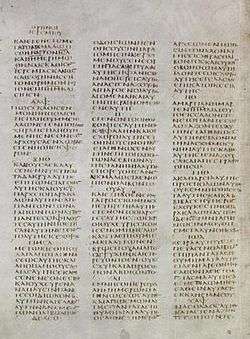Lamentations 2
| Lamentations 2 | |
|---|---|
|
Lamentations 1:1 - 1:11 on the first page of Book of Lamentations in Codex Sinaiticus (AD 330-350). | |
| Book | Book of Lamentations |
| Bible part | Old Testament |
| Order in the Bible part | 25 |
| Category | Ketuvim |
Lamentations 2 is the second chapter of the Book of Lamentations in the Hebrew Bible or the Old Testament of the Christian Bible.[1][2] This book contains the elegies of prophet Jeremiah as he lamenteth the misery of Jerusalem, and its causes, and their enemies’ derision, Lamentations 2:1-17; in exhortation to true sorrow and repentance; a fervent prayer, Lamentations 2:18-22.[3] It is a part of the Ketuvim ("Writings").[4][5]
Text
- The original text is written in Hebrew language.
- This chapter is divided into 22 verses.
- The chapter is acrostic, divided into twenty-two stanzas or verses. The stanzas consist of triplets of lines (excepting Lamentations 2:19, which contain four lines) each beginning with the letters of the Hebrew alphabet in regular order (twenty-two in number).[3]
- In verses 16-17, two letters are transposed. This is found is three instances in the whole book (Lamentations 2:16, 17; 3:46-51; 4:16, 17). Grotius thinks the reason for the inversion of two of the Hebrew letters, is that the Chaldeans, like the Arabians, used a different order from the Hebrews; in the first Elegy (chapter), Jeremiah speaks as a Hebrew, in the following ones, as one subject to the Chaldeans. However, this is doubtful.[3]
Textual versions
Some most ancient manuscripts containing this chapter in Hebrew language:
- Masoretic Text (10th century)
- Dead Sea Scrolls: (2nd century BC)[6][7]
- 4Q111 (4QLam): extant: verse 5[6]
Ancient translations in Koine Greek:
- Septuagint (3rd century BC)
- Theodotion version (~AD 180)
Structure
NKJV groups this chapter into:
- Lamentations 2:1-22 = God’s Anger with Jerusalem
Verse 1
- How hath the Lord covered the daughter of Zion with a cloud in his anger,
- and cast down from heaven unto the earth the beauty of Israel,
- and remembered not his footstool in the day of his anger![8]
- "How" (Hebrew, Eichah): the title of the collection repeated here, and in Lamentations 4:1.[3]
- "How hath the Lord covered": Or, "How" doth "אדני 'ădonāy cover."[9]
- "The daughter of Zion": i.e. Jerusalem.[10]
- "Cast down from heaven": Here and in Matthew 11:23 we have a parallel to Isaiah 14:12, where the King of Babylon is compared to a bright star. "Cast down" whither? Into the "pit" or dungeon of Hades (Isaiah 14:15).[10]
- "The beauty of Israel": i.e. Jerusalem, exactly as Babylon is called "the proud beauty [or, 'ornament'] of Chaldea" (Isaiah 13:19).[10]
- "His footstool": meaning either the house of the sanctuary, the temple itself, as containing the ark (1 Chronicles 28:2; Psalm 99:5),[10] as the Targum and Jarchi; or rather the ark (Psalm 132:7) with the mercy seat, on which the Shechinah or divine Majesty set his feet, when sitting between the cherubim; and is so called, 1 Chronicles 28:2.[11]
See also
- Related Bible parts: Psalm 99, Psalm 132, Isaiah 14, Matthew 11
Notes and references
- ↑ Collins 2014.
- ↑ Hayes 2015.
- 1 2 3 4 Robert Jamieson, Andrew Robert Fausset; David Brown. Jamieson, Fausset, and Brown's Commentary On the Whole Bible. 1871.
 This article incorporates text from this source, which is in the public domain.
This article incorporates text from this source, which is in the public domain. - ↑ Metzger, Bruce M., et al. The Oxford Companion to the Bible. New York: Oxford University Press, 1993.
- ↑ Keck, Leander E. 2001. The New Interpreter's Bible: Volume: VI. Nashville: Abingdon.
- 1 2 Dead sea scrolls - Lamentations
- ↑ Timothy A. J. Jull; Douglas J. Donahue; Magen Broshi; Emanuel Tov (1995). "Radiocarbon Dating of Scrolls and Linen Fragments from the Judean Desert". Radiocarbon. 38 (1): 14. Retrieved 26 November 2014.
- ↑ Lamentations 2:1
- ↑ Barnes, Albert. Notes on the Old Testament. London, Blackie & Son, 1884. Reprint, Grand Rapids: Baker Books, 1998.
 This article incorporates text from this source, which is in the public domain.
This article incorporates text from this source, which is in the public domain. - 1 2 3 4 Joseph S. Exell; Henry Donald Maurice Spence-Jones (Editors). The Pulpit Commentary. 23 volumes. First publication: 1890.
 This article incorporates text from this source, which is in the public domain.
This article incorporates text from this source, which is in the public domain. - ↑ John Gill. John Gill's Exposition of the Entire Bible. Exposition of the Old and New Testament. Published in 1746-1763.
 This article incorporates text from this source, which is in the public domain.
This article incorporates text from this source, which is in the public domain.
Bibliography
- Collins, John J. (2014). Introduction to the Hebrew Scriptures. Fortress Press.
- Hayes, Christine (2015). Introduction to the Bible. Yale University Press.
External links
Jewish
Christian
This article is issued from
Wikipedia.
The text is licensed under Creative Commons - Attribution - Sharealike.
Additional terms may apply for the media files.
